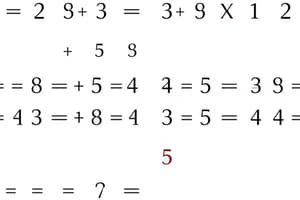Podcast
Questions and Answers
What is the value of 16! when calculated?
What is the value of 16! when calculated?
Which of the following represents the formula for permutations?
Which of the following represents the formula for permutations?
How many ways can first and second place be awarded to 10 people?
How many ways can first and second place be awarded to 10 people?
What happens to the number of arrangements when repetitions are allowed?
What happens to the number of arrangements when repetitions are allowed?
Signup and view all the answers
When using the factorial function, what does 0! equal?
When using the factorial function, what does 0! equal?
Signup and view all the answers
Which mathematical operation simplifies the equation 16!/(16 - 3)!?
Which mathematical operation simplifies the equation 16!/(16 - 3)!?
Signup and view all the answers
What is a distinguishing feature of combinations compared to permutations?
What is a distinguishing feature of combinations compared to permutations?
Signup and view all the answers
In the example of arranging 3 pool balls out of 16, what is the result of the calculation?
In the example of arranging 3 pool balls out of 16, what is the result of the calculation?
Signup and view all the answers
What is the primary distinction between combinations and permutations?
What is the primary distinction between combinations and permutations?
Signup and view all the answers
How many permutations can be formed when choosing 3 digits from 10 different numbers with repetition allowed?
How many permutations can be formed when choosing 3 digits from 10 different numbers with repetition allowed?
Signup and view all the answers
When calculating permutations without repetition, what happens to the number of choices available after each selection?
When calculating permutations without repetition, what happens to the number of choices available after each selection?
Signup and view all the answers
What formula represents the total number of permutations when repetition is allowed?
What formula represents the total number of permutations when repetition is allowed?
Signup and view all the answers
If you have a lock that requires a 3-digit combination using numbers from 0 to 9 with repetition not allowed, how many unique combinations can you create?
If you have a lock that requires a 3-digit combination using numbers from 0 to 9 with repetition not allowed, how many unique combinations can you create?
Signup and view all the answers
What is meant by 'ordered combination' in the context of permutations?
What is meant by 'ordered combination' in the context of permutations?
Signup and view all the answers
Which example best illustrates permutations with repetition?
Which example best illustrates permutations with repetition?
Signup and view all the answers
How many permutations can be created with 4 different colored balls selected from a set of 12, without repetition?
How many permutations can be created with 4 different colored balls selected from a set of 12, without repetition?
Signup and view all the answers
What does the notation C(n, r) represent?
What does the notation C(n, r) represent?
Signup and view all the answers
Using the formula n! / (r!(n-r)!), if n = 16 and r = 3, what is the result?
Using the formula n! / (r!(n-r)!), if n = 16 and r = 3, what is the result?
Signup and view all the answers
Which of the following correctly describes the difference between permutations and combinations?
Which of the following correctly describes the difference between permutations and combinations?
Signup and view all the answers
What is the value of 4! (4 factorial)?
What is the value of 4! (4 factorial)?
Signup and view all the answers
Why are the formulas n!/(r!(n-r)!) and n!/(n-r)!r! the same?
Why are the formulas n!/(r!(n-r)!) and n!/(n-r)!r! the same?
Signup and view all the answers
How many permutations are there for 3 distinct items?
How many permutations are there for 3 distinct items?
Signup and view all the answers
In Pascal's Triangle, how can you find the value for C(16, 3)?
In Pascal's Triangle, how can you find the value for C(16, 3)?
Signup and view all the answers
Which of the following is NOT a characteristic of combinations?
Which of the following is NOT a characteristic of combinations?
Signup and view all the answers
How many different ways can 3 scoops of ice cream be chosen from 5 flavors when repetition is allowed?
How many different ways can 3 scoops of ice cream be chosen from 5 flavors when repetition is allowed?
Signup and view all the answers
Which expression correctly represents the calculation for choosing 3 scoops from 5 flavors with repetition?
Which expression correctly represents the calculation for choosing 3 scoops from 5 flavors with repetition?
Signup and view all the answers
When using arrows and circles to denote scoops and spaces, how many arrows would there be if 3 scoops are taken from 5 flavors?
When using arrows and circles to denote scoops and spaces, how many arrows would there be if 3 scoops are taken from 5 flavors?
Signup and view all the answers
If a selection consists of 3 scoops and there are a total of 5 flavors available, how many boxes must be considered for arrows?
If a selection consists of 3 scoops and there are a total of 5 flavors available, how many boxes must be considered for arrows?
Signup and view all the answers
In the problem of choosing ice cream scoops, which of the following is False?
In the problem of choosing ice cream scoops, which of the following is False?
Signup and view all the answers
Which of the following represents the combination formula applied in this scenario?
Which of the following represents the combination formula applied in this scenario?
Signup and view all the answers
What concept does the use of arrows and circles help illustrate in this problem?
What concept does the use of arrows and circles help illustrate in this problem?
Signup and view all the answers
If the expression $(r + n - 1)!/(r!(n - 1)!)$ were to represent scoops and flavors, what does $n$ signify?
If the expression $(r + n - 1)!/(r!(n - 1)!)$ were to represent scoops and flavors, what does $n$ signify?
Signup and view all the answers
Study Notes
Combinations and Permutations
- Combination: Loosely used in everyday language, implying order doesn't matter.
- Permutation: Used in mathematics, meaning order matters
- Fruit Salad Example: "My fruit salad is a combination of apples, grapes, and bananas" Order of fruit doesn't affect the salad. "The combination to the safe is 472" Order of numbers is crucial.
Mathematical Definitions
- Combination: When the order of items does not matter.
- Permutation: When the order of items does matter.
Permutations with Repetition
- Definition: Choosing a certain number of items from a set with multiple identical items.
- Formula: nr (n multiplied r times)
- Example: A lock with 10 digits, choosing 3 digits for combination. 103 = 1000 possible combinations.
Permutations without Repetition
- Definition: Choosing items from a set without replacement, where order matters.
- Example: Choosing the first three people in a race; you can't be first and second.
- Formula: n × (n-1) × (n-2) × ... (n-r+1)
- Example: If you have 16 pool balls and want to arrange 3 of them in a specific order, the formula is 16 × 15 × 14 = 3,360 possible arrangements.
Factorial Function
- Symbol: !
- Definition: Used to denote the result of multiplying a sequence of descending natural numbers.
- Example: 4! = 4 × 3 × 2 × 1 = 24, 7! = 7 × 6 × 5 × 4 × 3 × 2 × 1 = 5040
Combinations without Repetition
- Definition: Choosing items from a set without replacement, where order does not matter.
- Formula: n! / (r! × (n-r)!) where n is the number of items to choose from and r is the number of items to choose.
- Example: Choosing 3 out of 16 pool balls (order doesn't matter)
- Formula: 16! / (3! × 13!) = 560 different combinations.
Combinations with Repetition
- Definition: Choosing items from a set with replacement, where order does not matter.
- Formula: (r + n - 1)! / (r! × (n-1)!) where n is the number of types of items and r is the number of items.
- Example: Choosing 3 scoops of ice cream from 5 flavors.
- Formula: (3 + 5 - 1)! / (3! × (5 - 1)!) = 35 different combinations.
Studying That Suits You
Use AI to generate personalized quizzes and flashcards to suit your learning preferences.
Related Documents
Description
Test your understanding of combinations and permutations in mathematics through this engaging quiz. Explore the difference between combinations where order does not matter and permutations where it does, along with examples and formulas. Perfect for students learning these concepts in math classes.




